087. African Openbill Anastomus lamelligerus (Oopbekooievaar)
Order: Ciconiiformes. Family: Ciconiidae
Description
60 cm. A small stork appearing all-black. Black head, brown eye and tawny bill, grey and black throat, black upperparts and long, black legs. Shiny wings. At close range the gap between the mandibles is visible.
Sexes similar, male is larger with larger bill.
Juvenile is like ad but duller; bill initially straight and shorter.
Distribution
Across much of sub-Saharan Africa, from Mali to Ethiopia south to South Africa. In southern Africa, it is locally common in Mozambique, Zimbabwe, eastern South Africa (only in Kruger National park and northern Natal), northern Botswana and northern Namibia.
Habitat
Single or in flocks at large rivers, floodlands and pans in wooded regions.
Diet
It almost exclusively eats snails and bivalves. The bill is specialised for feeding on molluscs and bivalves. The lower mandible is used to slice through the muscle holding either the snail in its shell or the 2 halves of a bivalve shell. The upper mandible is used to steady the prey while the extraction is performed. The bird uses the sharp tip of its lower mandible to get past the protective plate which snails use to seal themselves into their shell.
Breeding
Monogamous, breeding in colonies, with 4-20 nests per tree. The nest is built by both sexes in roughly a week, consisting of a thin platform of sticks and twigs, lined with leaves, grass, sedges and other aquatic plants. It is typically placed in a tree or bush on an island or partially submerged area.
Egg-laying season is from August-May, peaking from January-March. It lays 3-5 eggs, which are incubated by both sexes for about 21-30 days. The chicks are fed by both parents on a diet of shelled snails, since even at 42 days old they still cannot extract the meat from the shell. They leave the nest at about 50-55 days old.
Call
Raucous croaks and honks. Listen to Bird Call.
Status
Locally common. May be resident or nomadic. Not globally threatened, although it is now classified as Near-threatened in South Africa, largely due to pesticides added to water to control mosquito populations, habitat loss and entanglement in fishing lines.
Africa Wild Bird Book
- Bushveld Jock
- Posts: 2001
- Joined: Sat Jun 02, 2012 3:52 pm
- Contact:
- Bushveld Jock
- Posts: 2001
- Joined: Sat Jun 02, 2012 3:52 pm
- Contact:
African Openbill Photos
087. African Openbill Anastomus lamelligerus (Oopbekooievaar)

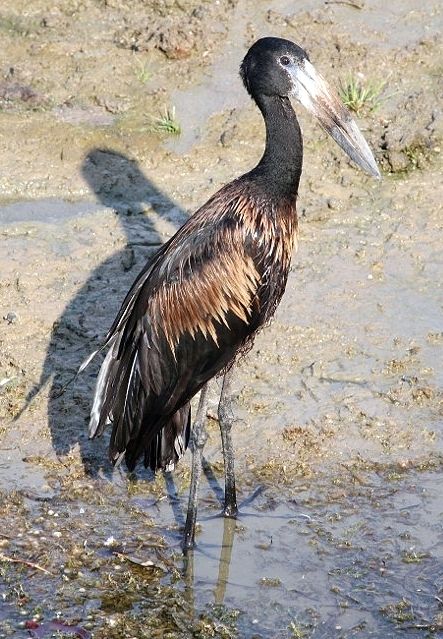 © nan
© nan
 © Borderline
© Borderline
Links:
Species text Sabap1
Sabap2
James Hancock, James A. Kushlan, M. Philip Kahl. Storks, Ibises and Spoonbills of the World
Oiseaux net: http://www.oiseaux-birds.com/card-african-openbill.html
http://cmsdata.iucn.org/downloads/speci ... lluscs.pdf

 © nan
© nan © Borderline
© BorderlineLinks:
Species text Sabap1
Sabap2
James Hancock, James A. Kushlan, M. Philip Kahl. Storks, Ibises and Spoonbills of the World
Oiseaux net: http://www.oiseaux-birds.com/card-african-openbill.html
http://cmsdata.iucn.org/downloads/speci ... lluscs.pdf
- nan
- Posts: 26476
- Joined: Thu May 31, 2012 9:41 pm
- Country: Switzerland
- Location: Central Europe
- Contact:
Abdim's Stork
085. Abdim's Stork Ciconia abdimii (Kleinswartooievaar)
Order: Ciconiiformes. Family: Ciconiidae
Description
Size: 73 cm. The smallest of the storks. Mainly black, with a purple sheen to their feathers. The belly and rump are white and the bare skin on their cheeks is blue, being duller when they are not breeding. There is a red patch in front of the eyes. The bill and legs are olive green to grey and their toes and knees are red. Like several other stork species, Abdim’s Storks defecate on their legs to assist with cooling in the hot weather. Sexes are similar.
The female is slightly smaller than male. The juvenile is duller than the adult.
Similar species: Distinguished from the larger Black Stork by its smaller size (76-81 cm) white (not black) lower back and rump, greyish (not red) legs with pink ankles, and greyish (not red) bill. In flight, legs do not project as far beyond the end of the tail as they do in Black Stork.
Distribution
It occurs across much of sub-Saharan Africa. In southern Africa it is common to locally abundant in western Mozambique, Zimbabwe, northern and north-eastern South Africa, Botswana and Namibia.
Habitat
Open fields and agricultural lands, often in the company of White Storks. It generally prefers savanna woodland, grassland, pastures, pan edges, cultivated land and suburban areas.
Movements and migrations
Non-breeding visitor to southern Africa, departing from its northern breeding grounds in East and West Africa in the period from May-August, eventually arriving in southern Africa at the onset of the rainy season in the period from October-December. It is nomadic in southern Africa, moving in response to food availability. It gathers in large flocks then departs in February, March and early April.
Diet
It mainly eats large insects, doing most of its foraging on pastures, irrigated land and recently ploughed fields, usually in groups which split up to cover more ground.
Breeding
The species breeds colonially, with nests being built from sticks and vegetation in trees or on cliffs, or on the roofs of huts in villages, and will often be used from year to year unless they collapse (although not necessarily by the same breeding pair).
Call
Usually silent in the region; a weak, two-note whistle is given at roosts.
Status
Common summer visitor, usually in large flocks. Classified as Least Concern (LC) on the IUCN Red List.
Order: Ciconiiformes. Family: Ciconiidae
Description
Size: 73 cm. The smallest of the storks. Mainly black, with a purple sheen to their feathers. The belly and rump are white and the bare skin on their cheeks is blue, being duller when they are not breeding. There is a red patch in front of the eyes. The bill and legs are olive green to grey and their toes and knees are red. Like several other stork species, Abdim’s Storks defecate on their legs to assist with cooling in the hot weather. Sexes are similar.
The female is slightly smaller than male. The juvenile is duller than the adult.
Similar species: Distinguished from the larger Black Stork by its smaller size (76-81 cm) white (not black) lower back and rump, greyish (not red) legs with pink ankles, and greyish (not red) bill. In flight, legs do not project as far beyond the end of the tail as they do in Black Stork.
Distribution
It occurs across much of sub-Saharan Africa. In southern Africa it is common to locally abundant in western Mozambique, Zimbabwe, northern and north-eastern South Africa, Botswana and Namibia.
Habitat
Open fields and agricultural lands, often in the company of White Storks. It generally prefers savanna woodland, grassland, pastures, pan edges, cultivated land and suburban areas.
Movements and migrations
Non-breeding visitor to southern Africa, departing from its northern breeding grounds in East and West Africa in the period from May-August, eventually arriving in southern Africa at the onset of the rainy season in the period from October-December. It is nomadic in southern Africa, moving in response to food availability. It gathers in large flocks then departs in February, March and early April.
Diet
It mainly eats large insects, doing most of its foraging on pastures, irrigated land and recently ploughed fields, usually in groups which split up to cover more ground.
Breeding
The species breeds colonially, with nests being built from sticks and vegetation in trees or on cliffs, or on the roofs of huts in villages, and will often be used from year to year unless they collapse (although not necessarily by the same breeding pair).
Call
Usually silent in the region; a weak, two-note whistle is given at roosts.
Status
Common summer visitor, usually in large flocks. Classified as Least Concern (LC) on the IUCN Red List.
- nan
- Posts: 26476
- Joined: Thu May 31, 2012 9:41 pm
- Country: Switzerland
- Location: Central Europe
- Contact:
Abdim's Stork Photos
085. Abdim's Stork Ciconia abdimii
 © nan
© nan
Kgalagadi Transfrontier Park
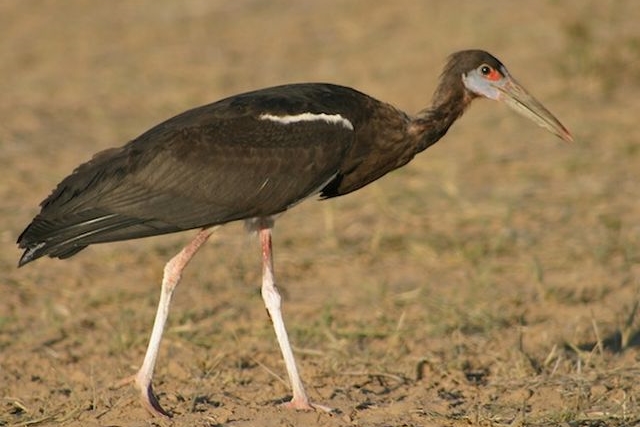 © ExFmem
© ExFmem
Kruger National Park, H7
 © nan
© nan
Lijersdraai, Kgalagadi TFP
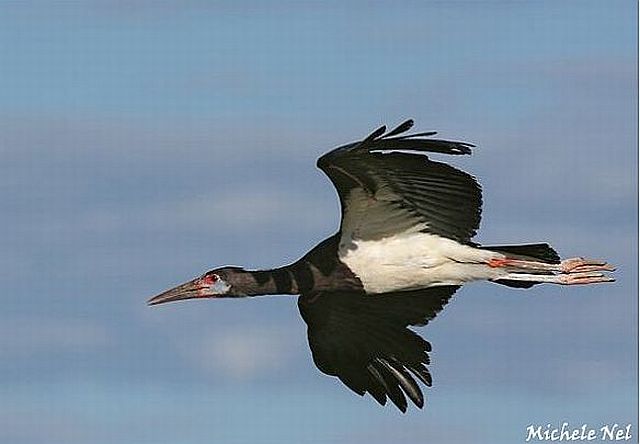 © Michele Nel
© Michele Nel
Links:
Species text in The Atlas of Southern African Birds
Sabap2
Oiseaux net: http://www.oiseaux-birds.com/card-abdim-stork.html
James Hancock, James A. Kushlan, M. Philip Kahl: Storks, Ibises and Spoonbills of the World
 © nan
© nanKgalagadi Transfrontier Park
 © ExFmem
© ExFmemKruger National Park, H7
 © nan
© nanLijersdraai, Kgalagadi TFP
 © Michele Nel
© Michele NelLinks:
Species text in The Atlas of Southern African Birds
Sabap2
Oiseaux net: http://www.oiseaux-birds.com/card-abdim-stork.html
James Hancock, James A. Kushlan, M. Philip Kahl: Storks, Ibises and Spoonbills of the World
- Flutterby
- Posts: 44029
- Joined: Sat May 19, 2012 12:28 pm
- Country: South Africa
- Location: Gauteng, South Africa
- Contact:
White Stork
083. White Stork Ciconia ciconia (Witooievaar)
Order: Ciconiiformes. Family: Ciconiidae
Description
1.13 m; 3.5 kg. It is a large bird, mainly white with black flight feathers and wing coverts, with long red legs, a long neck, and a long, straight, pointed red bill.
Sexes are alike except that males are larger than females.
Juveniles have a darker bill with reddish base, legs dull brownish, and white plumage is tinged with brown.
Distribution
Breeds in parts of Eurasia and North Africa, heading south in the non-breeding season to sub-Saharan Africa. In southern Africa, it is common to abundant in Zimbabwe, Botswana, Namibia, Mozambique and South Africa, largely excluding the arid Karoo. It has a small breeding population in the Western Cape.
Habitat
Open woodland, grassy Karoo, grassland, wetlands and cultivated land.
Migration
The White Stork is a long-distance migrant, wintering in Africa, or India. When migrating between Europe and Africa, it avoids crossing the Mediterranean Sea and detours via Israel in the east or the Strait of Gibraltar in the west, because the air thermals do not form over water.
It leaves its Eurasian breeding grounds to travel south all the way to southern Africa, where it stays from October-May. It is also a breeding resident in parts of the Western Cape, from the Agulhas Plain to Mossel Bay, although juveniles may join migrants in their trip north.
Diet
The White Stork's preferred feeding grounds are grassy meadows, farmland and shallow wetlands. They consume a wide variety of animal prey. Common food items include insects, earthworms, reptiles, amphibians, particularly frog species and small mammals such as voles, moles, and shrews.
Breeding
Southern African breeding population never known to exceed 10 pairs. Monogamous. The White Stork breeds in open farmland areas with access to marshy wetlands, building a large stick nest in trees, on buildings, or on purpose-built man-made platforms. The nest is used year after year and a single brood is raised. Normally four white eggs are laid, which are incubated for 33 to 34 days. Chicks fledge 58 to 64 days after hatching. White Storks generally begin breeding when about four years old.
Call
Mostly silent.
Status
Summer visitor. Usually in flocks of 10-50 birds. Common to abundant non-breading Palearctic migrant, with small breeding population in Western Cape. Numbers vary greatly between years; present October to May with a few injured or juvenile birds overwintering.
Order: Ciconiiformes. Family: Ciconiidae
Description
1.13 m; 3.5 kg. It is a large bird, mainly white with black flight feathers and wing coverts, with long red legs, a long neck, and a long, straight, pointed red bill.
Sexes are alike except that males are larger than females.
Juveniles have a darker bill with reddish base, legs dull brownish, and white plumage is tinged with brown.
Distribution
Breeds in parts of Eurasia and North Africa, heading south in the non-breeding season to sub-Saharan Africa. In southern Africa, it is common to abundant in Zimbabwe, Botswana, Namibia, Mozambique and South Africa, largely excluding the arid Karoo. It has a small breeding population in the Western Cape.
Habitat
Open woodland, grassy Karoo, grassland, wetlands and cultivated land.
Migration
The White Stork is a long-distance migrant, wintering in Africa, or India. When migrating between Europe and Africa, it avoids crossing the Mediterranean Sea and detours via Israel in the east or the Strait of Gibraltar in the west, because the air thermals do not form over water.
It leaves its Eurasian breeding grounds to travel south all the way to southern Africa, where it stays from October-May. It is also a breeding resident in parts of the Western Cape, from the Agulhas Plain to Mossel Bay, although juveniles may join migrants in their trip north.
Diet
The White Stork's preferred feeding grounds are grassy meadows, farmland and shallow wetlands. They consume a wide variety of animal prey. Common food items include insects, earthworms, reptiles, amphibians, particularly frog species and small mammals such as voles, moles, and shrews.
Breeding
Southern African breeding population never known to exceed 10 pairs. Monogamous. The White Stork breeds in open farmland areas with access to marshy wetlands, building a large stick nest in trees, on buildings, or on purpose-built man-made platforms. The nest is used year after year and a single brood is raised. Normally four white eggs are laid, which are incubated for 33 to 34 days. Chicks fledge 58 to 64 days after hatching. White Storks generally begin breeding when about four years old.
Call
Mostly silent.
Status
Summer visitor. Usually in flocks of 10-50 birds. Common to abundant non-breading Palearctic migrant, with small breeding population in Western Cape. Numbers vary greatly between years; present October to May with a few injured or juvenile birds overwintering.
- Flutterby
- Posts: 44029
- Joined: Sat May 19, 2012 12:28 pm
- Country: South Africa
- Location: Gauteng, South Africa
- Contact:
White Stork Photos
083. White Stork Ciconia ciconia
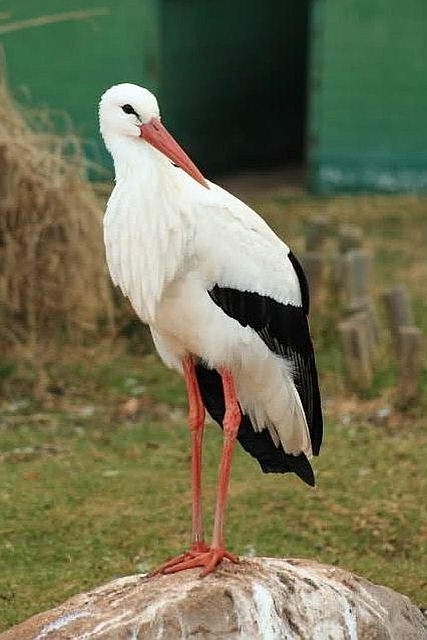
 © Dewi
© Dewi
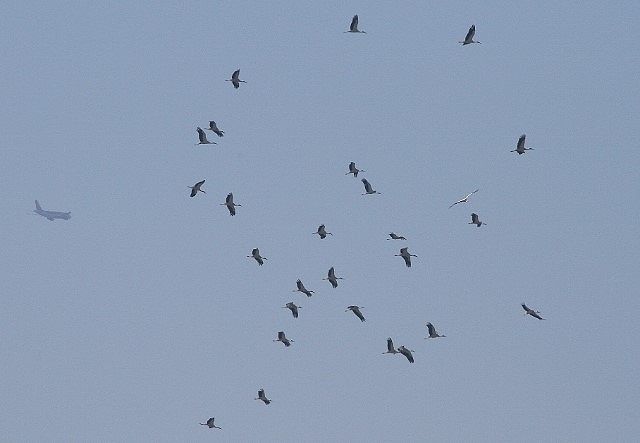 © nan
© nan
 © Dewi
© Dewi
Links:
Species text Sabap1
Sabap2
The Illustrated Encyclopedia Of European Birds

 © Dewi
© Dewi © nan
© nan © Dewi
© DewiLinks:
Species text Sabap1
Sabap2
The Illustrated Encyclopedia Of European Birds
Woolly-necked Stork
086. Woolly-necked Stork Ciconia episcopus Wolnekooievaar
Order: Ciconiiformes. Family: Ciconiidae
Description
It is a large wading bird, about 75-85 cm tall. Overall, these storks are predominantly black, with distinctive white necks that look woolly. The upperparts become a glossy purple during the breeding season. It has a white coloured throat and white lower belly and long red legs. The head is white with black 'skull cap' and a black bill. The eyes are crimson. Sexes are alike.
Juvenile birds are duller versions of the adult.
Distribution
It occurs from India and Sri Lanka east to the Philippines, as well as in sub-Saharan Africa between 15°N and 20°S, from Senegal to Ethiopia south to southern Africa (Mozambique, northern and southern Zimbabwe, northern Botswana, northern Namibia, and eastern South Africa; resident in eastern South Africa and parts of Mozambique and Botswana, while a non-breeding visitor to northern Namibia, Zimbabwe and also Botswana and Mozambique, staying from about November-April). There are both resident and migrant populations of Woolly-necked storks in the southern African region.
There are 3 subspecies; ssp microscelis is found in Africa, widespread in the tropical band, it is absent from only the very arid areas within this region. The subspecies episcopus is found in India, Indochina, the Malay peninsula and the Philippines while neglecta occours in Java and Wallacea.
Habitat
It can be found in any wetland habitat, generally preferring flood plains, rivers, pans, ponds, dams, lagoons, swamp forests, mangrove swamps, tidal mudflats, estuaries and also man-made habitats, including golf courses, firebreaks and roads in plantations. Although Woolly-necked Storks are associated with water they rarely wade.
Diet
It mainly eats insects and other invertebrates, but also fish, toads, frogs, crabs, snakes, lizards.
Breeding
Monogamous and usually a solitary nester, although it may breed in loose colonies of 4-5 pairs. The nest is built by both sexes, consisting of a platform of sticks with a central bowl lined with fine twigs, grass and green leaves. It is typically placed in the fork of a horizontal branch of a large tree, 10-50 metres above ground or water. Egg-laying season is from August-December. It lays 2-4 eggs, which are incubated by both sexes for about 30-31 days. The chicks are fed and brooded by both parents, leaving the nest to roost in a nearby tree at about 55-65 days old, becoming fully independent roughly three weeks later.
Status
Uncommon resident.
Order: Ciconiiformes. Family: Ciconiidae
Description
It is a large wading bird, about 75-85 cm tall. Overall, these storks are predominantly black, with distinctive white necks that look woolly. The upperparts become a glossy purple during the breeding season. It has a white coloured throat and white lower belly and long red legs. The head is white with black 'skull cap' and a black bill. The eyes are crimson. Sexes are alike.
Juvenile birds are duller versions of the adult.
Distribution
It occurs from India and Sri Lanka east to the Philippines, as well as in sub-Saharan Africa between 15°N and 20°S, from Senegal to Ethiopia south to southern Africa (Mozambique, northern and southern Zimbabwe, northern Botswana, northern Namibia, and eastern South Africa; resident in eastern South Africa and parts of Mozambique and Botswana, while a non-breeding visitor to northern Namibia, Zimbabwe and also Botswana and Mozambique, staying from about November-April). There are both resident and migrant populations of Woolly-necked storks in the southern African region.
There are 3 subspecies; ssp microscelis is found in Africa, widespread in the tropical band, it is absent from only the very arid areas within this region. The subspecies episcopus is found in India, Indochina, the Malay peninsula and the Philippines while neglecta occours in Java and Wallacea.
Habitat
It can be found in any wetland habitat, generally preferring flood plains, rivers, pans, ponds, dams, lagoons, swamp forests, mangrove swamps, tidal mudflats, estuaries and also man-made habitats, including golf courses, firebreaks and roads in plantations. Although Woolly-necked Storks are associated with water they rarely wade.
Diet
It mainly eats insects and other invertebrates, but also fish, toads, frogs, crabs, snakes, lizards.
Breeding
Monogamous and usually a solitary nester, although it may breed in loose colonies of 4-5 pairs. The nest is built by both sexes, consisting of a platform of sticks with a central bowl lined with fine twigs, grass and green leaves. It is typically placed in the fork of a horizontal branch of a large tree, 10-50 metres above ground or water. Egg-laying season is from August-December. It lays 2-4 eggs, which are incubated by both sexes for about 30-31 days. The chicks are fed and brooded by both parents, leaving the nest to roost in a nearby tree at about 55-65 days old, becoming fully independent roughly three weeks later.
Status
Uncommon resident.
Woolly-necked Stork Photos
086. Woolly-necked Stork Ciconia episcopus
 © Toko
© Toko
Ithala Game Reserve, KwaZulu-Natal
 © Dewi
© Dewi
© Flutterby
© Bush Brat

Kruger National Park, Orpen area, Dec 2020 © RogerFraser
Links:
http://sabap2.adu.org.za/spp_summary.ph ... §ion=3
http://www.oiseaux-birds.com/card-wooll ... stork.html
 © Toko
© TokoIthala Game Reserve, KwaZulu-Natal
 © Dewi
© Dewi© Flutterby
© Bush Brat
Kruger National Park, Orpen area, Dec 2020 © RogerFraser
Links:
http://sabap2.adu.org.za/spp_summary.ph ... §ion=3
http://www.oiseaux-birds.com/card-wooll ... stork.html
Black Stork
084. Black Stork Ciconia nigra (Gootswartooievaar)
Order: Ciconiiformes. Family: Ciconiidae
Description
Length 95-120 cm, weight 2.2-3.2 kg. The black head, upperparts, wings, tail and long neck have a conspicuous green or purple gloss, contrasting with the white lower breast, belly and undertail. When in full flight, you see that the underside of the wings is black with a white triangle at the base of the wing. The long legs and long, straight beak are bright red in adults, especially during the breeding season, and a patch of red skin surrounds the eye. The male and female black stork are similar in appearance, though the male may be slightly larger.
The juvenile has slightly browner, duller, less glossy plumage, and a pale olive-green beak and legs.
Distribution
Breeds from Japan and north-eastern China to western Europe and Denmark, heading south in the non-breeding season to northern India, eastern China and equatorial Africa. There is a separate resident population in Zambia, Angola and southern Africa, bordering on Mozambique and Botswana.
Habitat
It can occupy almost any type of wetland, such as pans, rivers, flood plains, ponds, lagoons, dams, swamp forests, mangrove swamps, estuaries, tidal mudflats and patches of short grass close to water.
Diet
It mainly eats fish, doing most of its foraging by wading through shallow water, stabbing at prey.
Breeding
Monogamous solitary nester, possibly with a life-long pair bond, sometimes sharing the nest cliff with birds of prey, such as Cape Vulture, Verreauxs' Eagle, Peregrine Falcon and Lanner Falcon. The nest is built and repaired by both sexes, consisting of a fairly flat platform of dry reeds, sticks and other dry plant matter, with a shallow central bowl lined with grass and other soft material. It is typically placed on a cliff ledge, pothole or cave, sometimes on top of the old nest of a Hamerkop, Verreauxs' Eagle or African Harrier-hawk. Egg-laying season is from April-September, peaking from May-August. It lays 2-5 eggs, which are incubated by both sexes for about 35-36 days. The chicks are brooded almost continually for the first 15 days or so of their lives and are fed by both parents. They leave the nest at about 63-71 days old, becoming fully independent roughly two weeks later.
Call
Usually silent. At nest gives a high-pitched whistling call. Listen to Bird Call.
Status
Uncommon to rare resident.
Order: Ciconiiformes. Family: Ciconiidae
Description
Length 95-120 cm, weight 2.2-3.2 kg. The black head, upperparts, wings, tail and long neck have a conspicuous green or purple gloss, contrasting with the white lower breast, belly and undertail. When in full flight, you see that the underside of the wings is black with a white triangle at the base of the wing. The long legs and long, straight beak are bright red in adults, especially during the breeding season, and a patch of red skin surrounds the eye. The male and female black stork are similar in appearance, though the male may be slightly larger.
The juvenile has slightly browner, duller, less glossy plumage, and a pale olive-green beak and legs.
Distribution
Breeds from Japan and north-eastern China to western Europe and Denmark, heading south in the non-breeding season to northern India, eastern China and equatorial Africa. There is a separate resident population in Zambia, Angola and southern Africa, bordering on Mozambique and Botswana.
Habitat
It can occupy almost any type of wetland, such as pans, rivers, flood plains, ponds, lagoons, dams, swamp forests, mangrove swamps, estuaries, tidal mudflats and patches of short grass close to water.
Diet
It mainly eats fish, doing most of its foraging by wading through shallow water, stabbing at prey.
Breeding
Monogamous solitary nester, possibly with a life-long pair bond, sometimes sharing the nest cliff with birds of prey, such as Cape Vulture, Verreauxs' Eagle, Peregrine Falcon and Lanner Falcon. The nest is built and repaired by both sexes, consisting of a fairly flat platform of dry reeds, sticks and other dry plant matter, with a shallow central bowl lined with grass and other soft material. It is typically placed on a cliff ledge, pothole or cave, sometimes on top of the old nest of a Hamerkop, Verreauxs' Eagle or African Harrier-hawk. Egg-laying season is from April-September, peaking from May-August. It lays 2-5 eggs, which are incubated by both sexes for about 35-36 days. The chicks are brooded almost continually for the first 15 days or so of their lives and are fed by both parents. They leave the nest at about 63-71 days old, becoming fully independent roughly two weeks later.
Call
Usually silent. At nest gives a high-pitched whistling call. Listen to Bird Call.
Status
Uncommon to rare resident.
Black Stork Photos
084. Black Stork Ciconia nigra
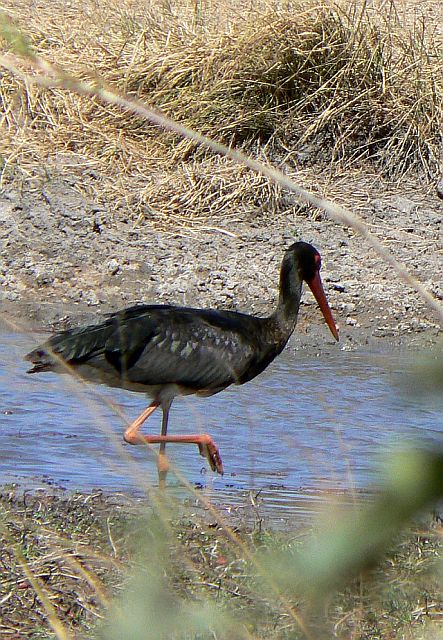 © Toko
© Toko
Kruger National Park
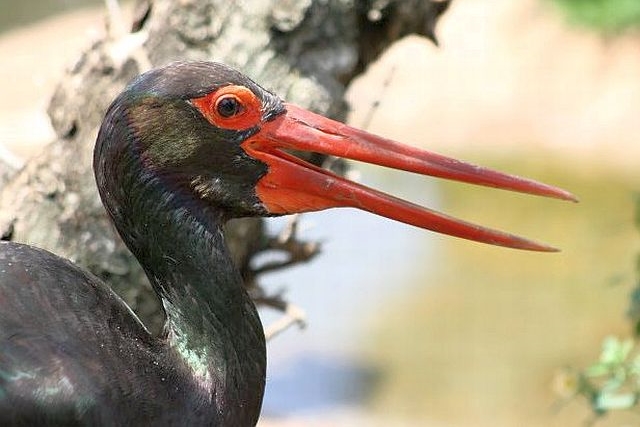 © Flutterby
© Flutterby
 © Heksie
© Heksie
 © Bushcraft
© Bushcraft
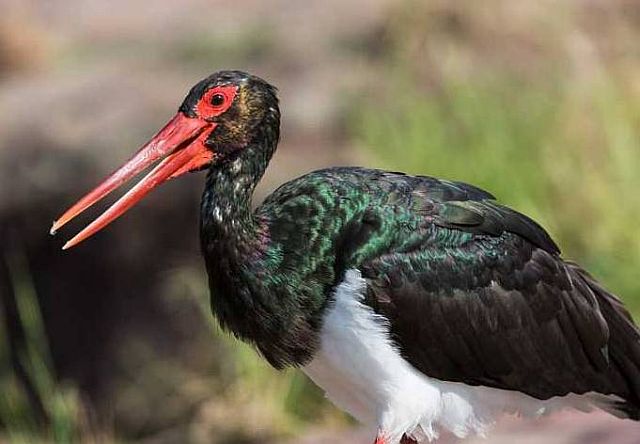 © Pumbaa
© Pumbaa
Kruger National Park
Links:
http://sabap2.adu.org.za/docs/sabap1/084.pdf
http://sabap2.adu.org.za/spp_summary.ph ... §ion=3
James Hancock, James A. Kushlan, M. Philip Kahl. Storks, Ibises and Spoonbills of the World
 © Toko
© TokoKruger National Park
 © Flutterby
© Flutterby © Heksie
© Heksie © Bushcraft
© Bushcraft © Pumbaa
© PumbaaKruger National Park
Links:
http://sabap2.adu.org.za/docs/sabap1/084.pdf
http://sabap2.adu.org.za/spp_summary.ph ... §ion=3
James Hancock, James A. Kushlan, M. Philip Kahl. Storks, Ibises and Spoonbills of the World


